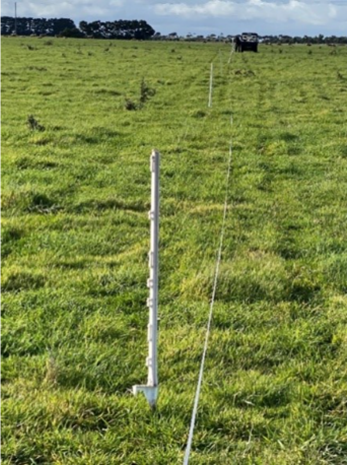Increasing lamb survival – Enhanced Producer Demonstration Site
Download a printable version of this page: Increased lamb survival ![]() [PDF File - 129.1 KB]
[PDF File - 129.1 KB]
Increasing lamb survival rates is a high priority for the sheep industry, providing both economic and welfare benefits. In 2016, the Western Plains Best Wool/Best Lamb (BWBL) group experienced a challenging lambing year with significant losses across ten farms. Accordingly, the group identified lamb survival as a high priority and were keen to test recommendations from relevant research projects on their own farms.
Three key management strategies of mob size, ewe condition score and shelter at lambing were investigated to assess their potential to increase lamb survival from twin-bearing ewes. The demonstration goal was to increase the survival of twin born lambs by 5-7%.
The Demonstration
The project was conducted over three lambing seasons from 2019 - 2021 across five sites in Western Victoria. All host producers commenced lambing in July, lambs were marked in September and mobs were inspected daily during lambing for data collection. All ewes allocated to demonstration treatments had been scanned as twin bearing.
The impact of mob size on lamb survival was investigated in all three years. Temporary electric fencing was used to subdivide paddocks to keep a constant stocking rate between the different mob sizes, as well as allow for the increased number of lambing mobs. Small mob sizes averaged 45 ewes per lambing group and were compared to larger mobs that averaged 113 ewes.
In years one and two, the impact of ewe condition on lamb survival was also investigated. Ewes were drafted into high condition (averaging CS 3.5) and low condition (averaging CS 2.75) mobs prior to lambing, with lamb numbers collated at marking. Stocking rate and feed on offer were kept constant between treatment groups.
In the final year, the demonstration was expanded to include an investigation into the role of shelter on lamb survival. Twin bearing ewes were allocated to either an ‘open’ or ‘sheltered’ lambing paddock. Sheltered paddocks contained existing tree plantations and a native rush (Juncus subsecundus) growing throughout, in addition to strategically placed large square hay bales. Again, mob size and feed on offer were kept constant between the two groups.
Activities were held each year to increase skills and adoption, including Feed On Offer (FOO) measurements, temporary electric fencing demonstrations, a lamb autopsy workshop and annual results presentations.
Key Findings
All the three management interventions (mob size, condition score and shelter) had the potential to increase survival of twin lambs by the targeted 5-7%.
While greater ewe condition at lambing resulted in the greatest increase in twin lamb survival (up to 29%), it also had the greatest range of improvement (6-29%), indicating that responses to improved ewe condition are likely to be variable for different flocks or across different seasons.
While only studied over a single year, considerable gains to lamb survival were achieved via the provision of shelter at lambing. For the host farm (located at Drysdale, near Geelong) the provision of shelter resulted in a 12% increase in survival of twin lambs through to marking.
The gains in twin lamb survival due to smaller mob sizes at lambing was less than those achieved by either the provision of shelter or increased ewe condition. However, smaller mob sizes still achieved 3-8% higher survival rates of twin lambs.
Things to consider
Lamb losses are not always just the result of unfavourable weather. Making sure that ewes are in condition score 3 at lambing and are lambed down in smaller mobs will improve survival rates of twin lambs. The provision of shelter will further mitigate the negative effects of inclement weather at lambing.
lambed down in smaller mobs will improve survival rates of twin lambs. The provision of shelter will further mitigate the negative effects of inclement weather at lambing.
Sub dividing paddocks to facilitate smaller mobs at lambing does not have to be expensive or time consuming. The demonstration successfully used temporary electric fences with good results. After trialling smaller mob sizes at lambing through temporary electric fencing, some group members decided to upgrade to permanent fences.
Ensure you identify the cause of death of lambs on your property. Undertaking training in lamb autopsy technique was an important exercise for group members, as it allowed the development of appropriate management strategies. For example, if the dominant cause of lamb death was exposure, changes to shelter could be implemented (natural and artificial), whereas if the greatest cause of lamb death was related to dystocia/lamb size then changes in ewe management during pregnancy and possibly sire genotype could be investigated and altered.
Further reading
The findings of this demonstration aligned with research trials on mob size (Hancock et. al.), ewe condition (Oldham et. al.) and shelter (LifeTime Wool). Producers interested in any of the specific interventions are encouraged to read the background literature.
Hancock S, Lockwood A, Trompf J and Kubeil L (2019) Improving lamb survival by optimising lambing density- Final Report, Australian Wool Innovation Ltd
Oldham C M, Thompson A N, Ferguson M B, Gordon D J, Kearney G A and Paganoni B L (2011). The birthweight and survival of Merino lambs can be predicted from the profile of liveweight change of their mothers during pregnancy. Animal Production Science, 51, 776–783
https://www.wool.com/lifetime-wool/
Acknowledgement
This Enhanced Producer Demonstration Site (EPDS) was co-funded by Meat & Livestock Australia and Agriculture Victoria. The demonstration was undertaken by the Western Plains BestWool/BestLamb group with Cathy Mulligan (Agriculture Victoria) and Andrew Kennedy (group coordinator). Data collection and input from host producers is gratefully acknowledged.
For further information contact:
Nick Linden, Agriculture Victoria
Nick.Linden@agriculture.vic.gov.au